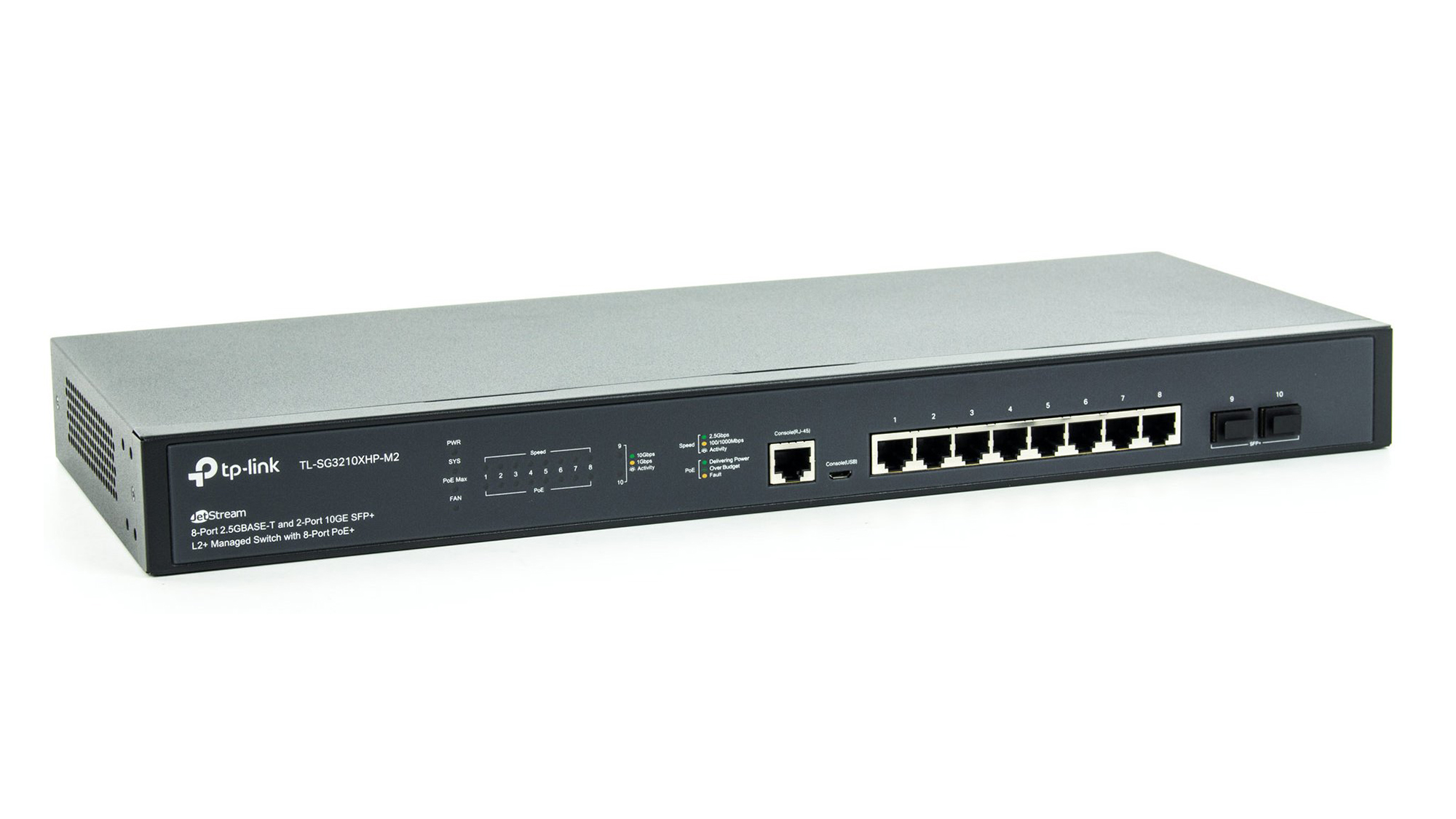TP-Link TL-SG3210XHP-M2 review: Any port in a storm
An affordable multi-Gig PoE+ switch with a big power budget and management features to match


-
+
Huge power budget
-
+
Great value
-
+
Ten multi-gigabit ports
-
-
Cloud portal doesn’t show all switch settings

When it’s time to move your office network onto Wi-Fi 6, you don’t want to be held back by a last-generation gigabit switch. To reap the full bandwidth of 802.11ax you need a multi-gigabit back-end. Thankfully, that doesn’t have to mean a jacked-up price: for a shockingly reasonable £263, TP-Link’s TL-SG3210XHP-M2 desktop/rack switch offers eight 2.5GbE ports and two high-speed 10GbE SFP+ fibre uplink ports.
That’s not all. Each of the switch’s eight copper ports presents 802.3af/at PoE+, with a generous total power budget of 240W. This means that the switch can deliver 30W on every multi-gig port at once, making it a great choice for anyone wanting to upgrade or install an office full of APs with a minimum of cabling.
The TL-SG3210XHP-M2 can be managed locally from a smartly designed web console. Standard L2 features are plentiful and include port, MAC and protocol-based VLANs, QoS traffic prioritisation and static and LACP link aggregation groups. There’s even a basic set of Layer 3 routing capabilities – sometimes referred to as Layer 3 Lite or Advanced L2+ – although the switch lacks the dynamic routing capabilities you’ll find on more expensive full Layer 3 switches.
VoIP networks are particularly well served. The switch can identify traffic from IP phones using their organisationally unique identifier (OUI) and prioritise it by dynamically creating voice VLANs. Switch monitoring and diagnostics features are a cut above the rest too: as well as supporting all versions of SNMP, the switch can run an internal sFlow agent for sending packet sampling data to a collector device – a feature we very rarely see at this sort of price.
As for power management, you can assign a priority to each port, and if the total power drain reaches the threshold, devices with the lowest priorities will be switched off first. It’s a simple, practical approach that we’ve seen on plenty of other switches – the only difference being that, in this case, the TL-SG3210XHP-M2’s big power budget means most offices won’t ever trigger it.
For larger organisations the switch can also be cloud-managed. Here TP-Link takes a similar approach to Ubiquiti Networks, with each site requiring a cloud controller to manage all local devices. You can download software for Windows and Linux that will handle this for free, but for testing we used TP-Link’s Omada OC300 hardware controller, a little black box that is preconfigured for the role and costs around £120.

All controllers assigned to your account appear in the cloud portal, and selecting one transports you to its management console. Adding the switch to our site was simple: as soon as we’d connected it to the office network, the controller detected it and presented it in the console as “pending”. We could then click to adopt it, after which the switch disabled its own web interface and took its settings from the controller.
Selecting the switch from the controller’s device page brings up a handy graphic showing which ports are active, with details of connection speed and power status. An overview below shows the power budget, with tabs provided for assigning profiles to each port, rebooting powered devices and viewing attached clients.
One slight oddity we noticed is that not all of the switch’s settings can be accessed from the cloud portal. But you can configure them in standalone mode, and then apply a cloud profile that tells the switch to keep its existing settings after adoption. Another option is to use the profile override feature to manually apply settings for functions such as port mirroring, PoE modes and rate limiting.
For monitoring on the move, TP-Link provides free mobile apps, and we tried using the iOS version on an iPad to check on our sites. We were happy to see plenty of status details, including full power consumption information, and controls to reboot the switch or upgrade its firmware.
Don’t be fooled by the low price: TP-Link’s TL-SG3210XHP-M2 offers a remarkable range of features. With ten multi-gig sockets, eight of them offering full PoE+ services, and a generous total power budget, it’s a terrifically versatile switch, and is particularly well suited to SMBs looking to deploy high-performance Wi-Fi 6 services.
TP-Link TL-SG3210XHP-M2 specifications
| Chassis | 1U rack/desktop chassis |
| Ports | 8 x 2.5GbE ports with PoE+, 2 x 10GbE SFP+ ports |
| Total power budget | 240W power budget |
| PoE standard | 802.3af/at PoE/PoE+ |
| Backplane capacity | 80Gbits/sec backplane capacity |
| Total MAC addresses | 16K MAC addresses |
| PSU | Internal PSU |
| Management | Web browser management, Omada controller software for Windows/Linux (free download) |
| Dimensions (WDH) | 440 x 180 x 44mm |
| Warranty | Limited lifetime warranty |
Get the ITPro daily newsletter
Sign up today and you will receive a free copy of our Future Focus 2025 report - the leading guidance on AI, cybersecurity and other IT challenges as per 700+ senior executives
Dave is an IT consultant and freelance journalist specialising in hands-on reviews of computer networking products covering all market sectors from small businesses to enterprises. Founder of Binary Testing Ltd – the UK’s premier independent network testing laboratory - Dave has over 45 years of experience in the IT industry.
Dave has produced many thousands of in-depth business networking product reviews from his lab which have been reproduced globally. Writing for ITPro and its sister title, PC Pro, he covers all areas of business IT infrastructure, including servers, storage, network security, data protection, cloud, infrastructure and services.
-
 ‘Phishing kits are a force multiplier': Cheap cyber crime kits can be bought on the dark web for less than $25 – and experts warn it’s lowering the barrier of entry for amateur hackers
‘Phishing kits are a force multiplier': Cheap cyber crime kits can be bought on the dark web for less than $25 – and experts warn it’s lowering the barrier of entry for amateur hackersNews Research from NordVPN shows phishing kits are now widely available on the dark web and via messaging apps like Telegram, and are often selling for less than $25.
By Emma Woollacott Published
-
 Redis unveils new tools for developers working on AI applications
Redis unveils new tools for developers working on AI applicationsNews Redis has announced new tools aimed at making it easier for AI developers to build applications and optimize large language model (LLM) outputs.
By Ross Kelly Published
-
 Google layoffs continue with "hundreds" cut from Chrome, Android, and Pixel teams
Google layoffs continue with "hundreds" cut from Chrome, Android, and Pixel teamsNews The tech giant's efficiency drive enters a third year with devices teams the latest target
By Bobby Hellard Published